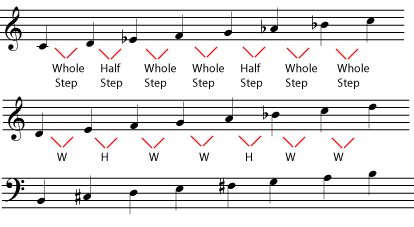

Now let’s take a look at what the two positions we just reviewed would look like in tab form. It’s just a matter of preference, but it’s a good idea to understand both methods. Some people find them easier to comprehend. While the diagrams above act as more of a roadmap, tabs are closer to step-by-step directions. Notice the difference in tones and feel, playing higher up on the fretboard.Īnother approach to learning scales that might be more familiar to some guitar players is using tabs to understand the notes of the scale in order. When you get to the 2nd string, your index finger will shift back to the 5th fret. One important thing to note is that when you reach the 3rd string, you’ll have to shift your hand to move your index finger to the 4th fret. You’ll then use your ring finger for the 7th fret of the same string, and your pinky finger for the 8th fret. Let’s start with our index finger on the 5th fret of the 6th (low E) string, another A note. By moving up the fretboard to approach the scale from a different starting position, you’ll be able to hear these same notes in a higher register. A Major Scale - 5th PositionĪnother way to play the A major scale is in the 5th position. From there you’d move up to the 2nd fret on the 5th string, B and the 3rd fret, C. Although there are some notes in the scale on the 6th (low E) string, it may make the most sense to start with the open A (5th string), in order to use the lowest possible A note as the root. Use your index finger for notes that fall on the 1st fret, middle finger for notes on the 2nd fret, and ring finger for notes on the 3rd fret. To play the A minor scale in open position, you will only need to play notes on the first three frets of your guitar.

Each A note across the fretboard in these examples will be highlighted in yellow to indicate where the scale starts over again. The yellow dots indicate the root note of the scale. A dot with a note above the string indicates an open string, where no frets will be pressed down. In the examples below, each dot shows you which note to play on a specific fret and string.
#Minor scale pattern how to
Learning to read guitar charts and diagrams can help you learn how to play scales and gain a deeper understanding of the notes and their corresponding frets.

These diagrams present a visual representation of the fretboard of your guitar. One of the easiest ways to learn the A minor scale is by referencing guitar scale diagrams. Now that you know the notes that make up the scale, we’ll show you where to place your fingers on the fretboard to play the A minor scale, note-by-note.īe the first to know about new products, featured content, exclusive offers and giveaways. That noted, the A minor scale is the relative minor of C major. In fact, it uses all the same notes as the C major scale, but instead uses the A note as its starting point. You’ll notice there are no sharps or flats in any of the notes in the A minor scale - just like the C major scale. The A minor scale is made up of these seven notes: Let’s get started! Notes in the A Minor Scale In this article, we’ll break down what notes make up the scale and demonstrate a few different ways to play it on guitar. Because it contains no sharps or flats, the A minor scale is a good scale for beginners to try to master, hearing each note in its purest form. Learning to play scales is a great way for guitarists to expand their range of abilities and their overall understanding of music theory. Lesson: Playing the A Minor Scale on Guitar


 0 kommentar(er)
0 kommentar(er)
